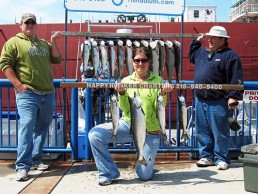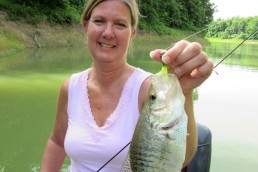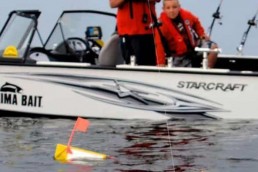Spring Surface Fishing with Planer Boards
SHARE THIS POST
Fishing the surface in springtime has always been one of my favorite methods. Rigging for surface trolling is largely a matter of personal preference. Each captain has his own method based on his experience and equipment.
Planer boards are available in a variety of sizes, some attach directly to your fishing line, and some have their own line running from an elevated mast. I prefer the Nordic-style single boards about 3-1/2-feet long; a bright colored braided line at least 100-pound-test. A rubber snubber between the board and line helps keep it on an even keel. I use seven-foot poles that are fairly limber and 30-pound braided line. I tie on 100 feet of mono 17- to 20-pound-test. On the end of that I tie a swivel, then a five-foot length of 15-pound fluorocarbon and finally a duo lock snap.
On a calm day, I let out up to 150 feet of line and attach with a clamp-type release (the release should be light enough to hold the braid without accidental releases). The advantage of the braid is that it is lighter and catches less wind and less sagging. Also, the release can be easily tripped with a slight snap of the rod. The mono acts like a shock absorber when the fish strikes and sets the hook by itself and it helps keep the line tight while fighting the fish. The swivel prevents line twist, should the stick bait foul or roll. It also keeps pollen and debris from getting to the lure and inhibiting the action.
Are you enjoying this post?
You can be among the first to get the latest info on where to go, what to use and how to use it!
The fluorocarbon leader has less visibility and is easy to detect nick and rough spots by feel. The duo lock allows free movement of the lure. That brings us to the lure itself. Hooks should be sharp and not bent; replacing hooks when they are dull, or damaged is better than filling. On stick baits with three trebles, I remove the front hook. It’s just more to get tangled in the net, and the fish can’t get hooked on the side of the head. Plus, it gives you replacement hooks when they need replacing.
For my side diver rods, I like 8-1/2- to 9-foot rods that are flexible enough to buffer the hard strike and run of the fish. Set the drag just light enough to hold, but you may have to loosen the drag quickly when the fish hits, to avoid pulling the hooks out. Go heavy on line here especially to the diver. I use at lease 30-pound braid to the diver then a snubber then five feet of 20-pound mono. I usually run spoons on the diver and run them very short, even where you can see the lure working.
The cohos are running large for this time of year and some kings in the four- to seven-pound class are being caught. The water is warming and it’s time to get your salmon fix.
MWO
SHARE THIS POST
Did you enjoy this post?
You can be among the first to get the latest info on where to go, what to use and how to use it!
Peter Dahl
MidWest Outdoors works with more than 200 outdoor experts each year, who contribute articles based on their areas of expertise. MidWest Outdoors magazine offers more fishing and hunting articles than any other publication!



